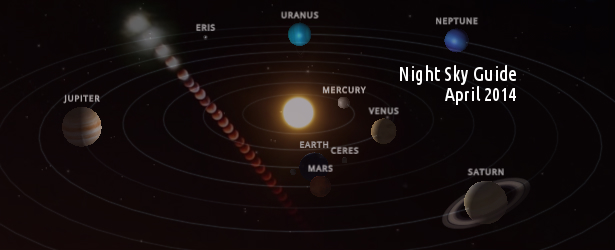Night sky guide for April 2014

April brings us several interesting events. It is a good month for eclipses and also the month when meteor activity picks up a bit as the Lyrids meteor shower become active. Earth and Mars will be at their minimum distance of 99 million km on April 14 but any clear night in April is a good time to look at Mars. On April 15 a total lunar eclipse will occur starting a tetrad of lunar eclipses for 2014. The month will end with the α–Scorpiid meteor shower and annular solar eclipse on April 29, first solar eclipse of 2014.
-
April 8 – Mars at opposition – 20:57 UTC. Mars will be opposite the Sun in Earth's sky. Mars, Earth, and the Sun will be arranged in a nearly-straight line.
-
April 12 – Virginid Meteor Shower. This meteor shower will reach its maximum rate of activity on April 12. Some shooting stars will be visible each night from April 7 to 18. The maximum number of meteors expected to be visible from a dark location is around 5 per hour (ZHR). The Moon will be 13 days old at the time of peak activity, and being close to Full Moon, it will severely limit the observations that will be possible.
-
April 14 – Earth and Mars are at their minimum distance: 92 million km. The full Moon will be gliding by Mars in the constellation Virgo. Since the size and brightness of Mars in the night sky both increase when it is close to us, the days around its perigee represent the best time to observe it.
-
April 15 – Full Moon. The Moon will be directly opposite the Earth from the Sun and will be fully illuminated as seen from Earth. This phase occurs at 07:42 UTC. This full moon was known by early Native American tribes as the Full Pink Moon because it marked the appearance of the moss pink, or wild ground phlox, which is one of the first spring flowers. This moon has also been known as the Sprouting Grass Moon and the Growing Moon.
-
April 15 – Total Lunar Eclipse. A total lunar eclipse occurs when the Moon passes completely through the Earth's dark shadow, or umbra. During this type of eclipse, the Moon will gradually get darker and then take on a rusty or blood red color. The eclipse will be visible throughout most of North America, South America, and Australia. (NASA Map and Eclipse Information)

-
April 16 – Saturn and the Moon will rise together in the evening and travel across the sky throughout the night.
-
April 21/22 – Lyrids Meteor Shower. The Lyrids is an average shower, usually producing about 20 meteors per hour at its peak. It is produced by dust particles left behind by comet C/1861 G1 Thatcher. The shower runs annually from April 16 – 25, its peak this year is on April 21/22. These meteors can sometimes produce bright dust trails that last for several seconds. The second quarter moon will be a slight problem this year, blocking the less bright meteors from view. Meteors will radiate from the constellation Lyra, but can appear anywhere in the sky. These meteors are best seen from the northern hemisphere where the radiant is high in the sky at dawn. Activity from this shower can be seen from the southern hemisphere, but at a lower rate.
-
April 28 – The α–Scorpiid Meteor Shower. Some shooting stars will be visible each night from April 20 to May 19, but the best show will be expected on or around April 28. The maximum number of meteors expected to be visible from a dark location is around 5 per hour (ZHR). The Moon will be 29 days old at the time of peak activity, and so will present minimal interference.
-
April 29 – New Moon. The Moon will be directly between the Earth and the Sun and will not be visible from Earth. This phase occurs at 06:14 UTC. This is the best time of the month to observe faint objects such as galaxies and star clusters because there is no moonlight to interfere.
-
April 29 – Annular Solar Eclipse. This is the first solar eclipse of 2014. An annular solar eclipse occurs when the Moon is too far away from the Earth to completely cover the Sun. This results in a ring of light around the darkened Moon. The Sun's corona is not visible during an annular eclipse. The path of the eclipse will begin off the coast of South Africa and move across Antarctica and into the east coast of Australia. Sky watchers in southern Indonesia and Australia will see partial solar eclipse. The first solar eclipse of 2014 occurs at the Moon's descending node in southern Aries. This particular eclipse is rather unusual because the central axis of the Moon's antumbral shadow misses Earth entirely while the shadow edge grazes the planet. Classified as a non-central annular eclipse, such events are rare. Out of the 3,956 annular eclipses occurring during the 5,000-year period -2000 to +3000, only 68 of them or 1.7% are non-central (Espenak and Meeus, 2006). (NASA Map and Eclipse Information)


Tonight's Sky: April 2014 – Video courtesy of Hubble Space Telescope


Sky & Telescope's SkyWeek – April 2014 – Videos courtesy of Sky & Telescope
Featured image: The Watchers (NASA & SolarSystemScope)

Commenting rules and guidelines
We value the thoughts and opinions of our readers and welcome healthy discussions on our website. In order to maintain a respectful and positive community, we ask that all commenters follow these rules.